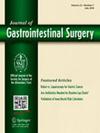恶性胃出口梗阻姑息干预的国家视角。
IF 2.4
3区 医学
Q3 GASTROENTEROLOGY & HEPATOLOGY
引用次数: 0
摘要
背景:大约 15-20% 的十二指肠或胰腺周围恶性肿瘤患者会出现 GOO。虽然有小型随机试验报告称 ES 可使患者恢复更快、住院时间更短,但在全国范围内对结果进行评估的研究却很有限。本研究对恶性胃出口梗阻(GOO)的胃空肠吻合术(GJ)与内镜支架植入术(ES)的短期临床和经济效果进行了评估:从2016-2020年全国再入院数据库中识别出接受ES或GJ治疗的恶性GOO成人。采用熵平衡法平衡各组间的协变量,并采用多变量回归法评估GJ或ES与院内死亡率、全肠外营养(TPN)使用、并发症、住院时间(LOS)、费用和90天再入院之间的关系:在8186名GOO患者中,68.4%接受了ES治疗,31.6%接受了GJ治疗。两组患者的年龄、性别和合并症相似,而 GJ 患者更常见于体弱者。经过风险调整后,GJ 和 ES 的死亡率、综合并发症和 90 天再入院率相当。GJ 患者输血(AOR 1.74 [95% CI [1.37-2.21])和术后使用 TPN(AOR 3.76 [95% CI 2.64-5.35])的几率更高。此外,GJ 患者的费用显著增加了 15,800 美元,LOS 增加了 6.9 天。对患有转移性疾病的患者进行亚组分析后发现,不同缓解策略的死亡率、并发症和再入院率仍然相当:结论:与 GJ 相比,ES 的短期发病率和死亡率与 GJ 相当,且能显著降低成本。增加使用内窥镜技术的机会,并将医疗服务区域化,使其集中在高流量中心,可能有助于改善恶性 GOO 患者的治疗效果。本文章由计算机程序翻译,如有差异,请以英文原文为准。
A national perspective on palliative interventions for malignant gastric outlet obstruction
Background
Of note, 15% to 20% of patients with duodenal or periampullary malignancies develop gastric outlet obstruction (GOO). Although small randomized trials have reported more rapid recovery and shorter hospital stay with endoscopic stenting (ES), limited studies have evaluated outcomes at a national level. The current study characterized short-term clinical and financial outcomes associated with gastrojejunostomy (GJ) vs ES in malignant GOO.
Methods
Adults with malignant GOO treated with ES or GJ were identified in the 2016–2020 Nationwide Readmissions Database. Entropy balancing was used to balance covariates between groups, and multivariate regression was used to evaluate the association between GJ or ES and in-hospital mortality, total parenteral nutrition (TPN) use, complications, length of stay (LOS), costs, and 90-day readmission.
Results
Of 8186 patients with GOO, 5603 (68.4%) underwent ES, and 2583 (31.6%) underwent GJ. The cohorts were similar in age, female/male sex, and comorbidities. However, patients who underwent GJ were more commonly frail. After risk adjustment, mortality, composite complications, and 90-day readmission were comparable between patients who underwent GJ and those who underwent ES. GJ was associated with greater odds of blood transfusion (adjusted odds ratio [AOR], 1.74; 95% CI, 1.37–2.21) and postoperative TPN use (AOR, 3.76; 95% CI, 2.64–5.35). Furthermore, patients who underwent GJ experienced a significant increment of >$15,800 in costs and >6.9 days in LOS. In subgroup analysis of patients with metastatic disease, mortality, complications, and readmission remained comparable among palliation strategies.
Conclusion
ES seems to yield comparable short-term morbidity and mortality relative to GJ with significant cost reduction. Increasing access to endoscopic technology and regionalizing care to high-volume centers may help improve outcomes for patients with malignant GOO.
求助全文
通过发布文献求助,成功后即可免费获取论文全文。
去求助
来源期刊
CiteScore
5.50
自引率
3.10%
发文量
319
审稿时长
2 months
期刊介绍:
The Journal of Gastrointestinal Surgery is a scholarly, peer-reviewed journal that updates the surgeon on the latest developments in gastrointestinal surgery. The journal includes original articles on surgery of the digestive tract; gastrointestinal images; "How I Do It" articles, subject reviews, book reports, editorial columns, the SSAT Presidential Address, articles by a guest orator, symposia, letters, results of conferences and more. This is the official publication of the Society for Surgery of the Alimentary Tract. The journal functions as an outstanding forum for continuing education in surgery and diseases of the gastrointestinal tract.

 求助内容:
求助内容: 应助结果提醒方式:
应助结果提醒方式:


